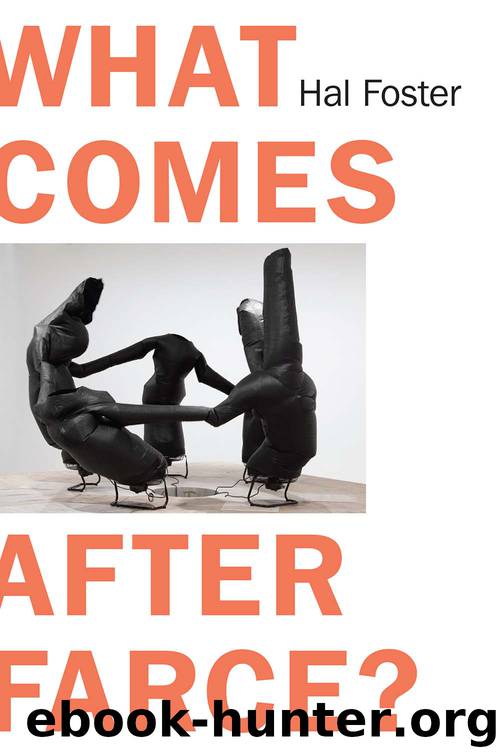What Comes After Farce by Hal Foster

Author:Hal Foster
Language: eng
Format: epub
Publisher: Verso Books
Harun Farocki, Images of the World and the Inscription of War, 1988. 16mm film, color and black-and-white, 75 minutes. © Harun Farocki GbR.
Our representational devices inform not only how we see but also how we appear, and Images of the World pressures this tension between imaging and being imaged. In the Auschwitz sequence, Farocki lingers over an extraordinary photograph of a new arrival to the camp, an attractive woman in an overcoat, who darts a furtive glance at the camera, while behind her a Nazi soldier inspects several male inmates. Even now, the implication of gazes here is difficult to bear, but at least the woman retains enough self-possession to look back at her Nazi photographer with what appears to be a mix of fear and outrage. Elsewhere in the film, Farocki presents another stark encounter between camera and subject: archival portraits of Algerian women photographed in 1960, for the first time without veils, by the French military for purposes of identification during the war. These women are exposed in every sense of the word, but the violation is also literally faced and mutely resisted.13 Toward the end of Images of the World, when Farocki shows us a life-drawing class in session, the cumulative effect of his montage is such that we can no longer hold humanist uses of seeing, measuring, and imaging apart from military, industrial, and bureaucratic abuses of such techniques. While some of us are positioned as objects of this general image-science, Farocki concludes, others are set up as its operators. Then, too, we might occupy both positions; our training is as innocuous as playing a computer game or watching a war report on television.
Farocki pursues this concern with training in How To Live in the German Federal Republic, which draws heavily on instructional tapes—a young boy quizzed with a block puzzle, pregnant parents coached with baby dolls, schoolchildren drilled about street traffic, bank tellers and police cadets trained in dispute management—in order to suggest how lessons in proper behavior shade into forced socialization.14 (In this footage, not only are people tested, but so too are things, such as drawers, chairs, and toilet seats, subjected to robotic abuse; it appears that the ideal of all these test subjects, human and other, is to be an object that can withstand a beating.) In an administered society, Farocki suggests, how to live has all but subsumed living as such, and in this respect the film looks ahead to our present regime of relentless testing and continuous retooling.15 Moreover, as a documentary of dramatizations, How to Live also anticipates our post-Warholian age of reality television, in which real life often feels real only if it is performed and living sometimes seems synonymous with acting out. While Farocki develops related lines of inquiry in his later films on prisons and shopping malls, Eye/Machine III links them directly with the themes first broached in Images of the World.
Like Images of the World, the Eye/Machine trilogy reflects on instruments of work, war, and
Download
This site does not store any files on its server. We only index and link to content provided by other sites. Please contact the content providers to delete copyright contents if any and email us, we'll remove relevant links or contents immediately.
The Secret History by Donna Tartt(18929)
The Social Justice Warrior Handbook by Lisa De Pasquale(12160)
Thirteen Reasons Why by Jay Asher(8831)
This Is How You Lose Her by Junot Diaz(6825)
Weapons of Math Destruction by Cathy O'Neil(6200)
Zero to One by Peter Thiel(5720)
Beartown by Fredrik Backman(5660)
The Myth of the Strong Leader by Archie Brown(5449)
The Fire Next Time by James Baldwin(5366)
How Democracies Die by Steven Levitsky & Daniel Ziblatt(5165)
Promise Me, Dad by Joe Biden(5108)
Stone's Rules by Roger Stone(5045)
A Higher Loyalty: Truth, Lies, and Leadership by James Comey(4899)
100 Deadly Skills by Clint Emerson(4872)
Rise and Kill First by Ronen Bergman(4732)
Secrecy World by Jake Bernstein(4693)
The David Icke Guide to the Global Conspiracy (and how to end it) by David Icke(4650)
The Farm by Tom Rob Smith(4460)
The Doomsday Machine by Daniel Ellsberg(4441)
